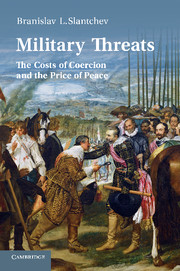Book contents
- Frontmatter
- Contents
- List of figures
- List of tables
- Acknowledgements
- Part I Coercion and Credibility
- Part II A Theory of Military Threats
- Part III Elements of Militarized Deterrence
- 5 Militarization and the Distribution of Power and Interests
- 6 The Expansion of the Korean War, 1950
- 7 The Price of Peace and Military Threat Effectiveness
- Part IV Conclusions
- Appendix A Formalities for Chapter 2
- Appendix B Formalities for Chapter 3
- Appendix C Formalities for Chapter 4
- Appendix D Formalities for Chapter 5
- Bibliography
- Index
7 - The Price of Peace and Military Threat Effectiveness
Published online by Cambridge University Press: 03 February 2011
- Frontmatter
- Contents
- List of figures
- List of tables
- Acknowledgements
- Part I Coercion and Credibility
- Part II A Theory of Military Threats
- Part III Elements of Militarized Deterrence
- 5 Militarization and the Distribution of Power and Interests
- 6 The Expansion of the Korean War, 1950
- 7 The Price of Peace and Military Threat Effectiveness
- Part IV Conclusions
- Appendix A Formalities for Chapter 2
- Appendix B Formalities for Chapter 3
- Appendix C Formalities for Chapter 4
- Appendix D Formalities for Chapter 5
- Bibliography
- Index
Summary
I have yet to see any problem, however complicated, which, when looked at in just the right way, did not become still more complicated.
Paul AndersonAfter the December 13, 2001 terrorist attack on the Indian Parliament, the strained relations between India and Pakistan reached the breaking point. India accused Pakistan of supporting the terrorists and demanded that Pakistan apprehend the leaders of their organizations and stop supporting them financially. When Pakistan's forces went on high alert in response to these bellicose statements, India mobilized over half a million troops and deployed them in Kashmir and Punjab toward the border with Pakistan. At the height of the conflict, “more than 1 million troops [stood] toe-to-toe along the 1,800-mile India–Pakistan border.”
The two countries, both officially in possession of nuclear weapons since 1998, also traded nuclear threats during the tense standoff. However, after some limited clashes in May and June 2002, the crisis deescalated and in October the two antagonists began demobilizations that led to a cease-fire in 2003. The massive Indian mobilization coupled with the bellicose statements of many of its politicians calling for blood, worried many observers at the time. There was great concern that should war erupt, it may escalate into a nuclear exchange, a scenario for which the Defense Intelligence Agency projected over 8 million dead in the strikes alone.
- Type
- Chapter
- Information
- Military ThreatsThe Costs of Coercion and the Price of Peace, pp. 224 - 252Publisher: Cambridge University PressPrint publication year: 2011



